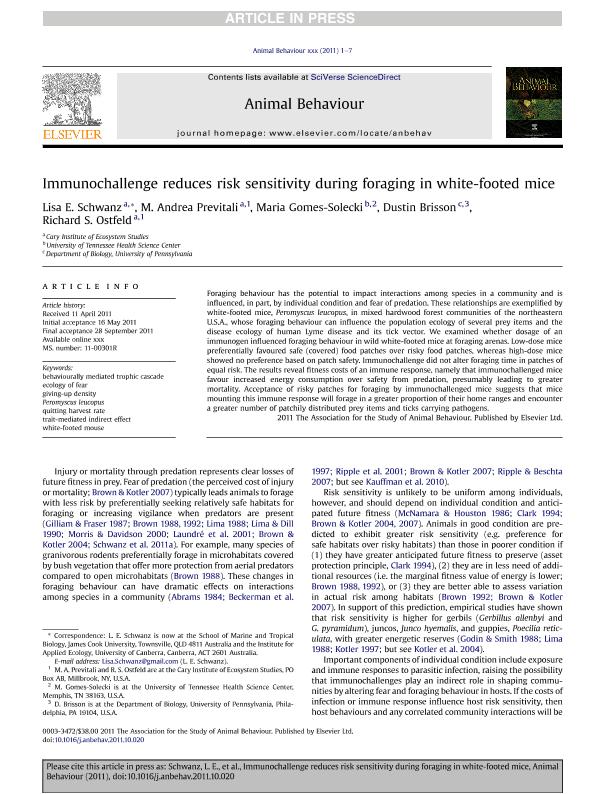Mostrar el registro sencillo del ítem
dc.contributor.author
Schwanz, Lisa E.
dc.contributor.author
Previtali, Maria Andrea

dc.contributor.author
Gomes-Solecki, Maria
dc.contributor.author
Brisson, Dustin
dc.contributor.author
Ostfeld, Richard S.
dc.date.available
2018-09-20T16:50:45Z
dc.date.issued
2012-01
dc.identifier.citation
Schwanz, Lisa E.; Previtali, Maria Andrea; Gomes-Solecki, Maria; Brisson, Dustin; Ostfeld, Richard S.; Immunochallenge reduces risk sensitivity during foraging in white-footed mice; Academic Press Ltd - Elsevier Science Ltd; Animal Behaviour; 83; 1; 1-2012; 155-161
dc.identifier.issn
0003-3472
dc.identifier.uri
http://hdl.handle.net/11336/60442
dc.description.abstract
Foraging behaviour has the potential to impact interactions among species in a community and is influenced, in part, by individual condition and fear of predation. These relationships are exemplified by white-footed mice, Peromyscus leucopus, in mixed hardwood forest communities of the northeastern U.S.A., whose foraging behaviour can influence the population ecology of several prey items and the disease ecology of human Lyme disease and its tick vector. We examined whether dosage of an immunogen influenced foraging behaviour in wild white-footed mice at foraging arenas. Low-dose mice preferentially favoured safe (covered) food patches over risky food patches, whereas high-dose mice showed no preference based on patch safety. Immunochallenge did not alter foraging time in patches of equal risk. The results reveal fitness costs of an immune response, namely that immunochallenged mice favour increased energy consumption over safety from predation, presumably leading to greater mortality. Acceptance of risky patches for foraging by immunochallenged mice suggests that mice mounting this immune response will forage in a greater proportion of their home ranges and encounter a greater number of patchily distributed prey items and ticks carrying pathogens. © 2011 The Association for the Study of Animal Behaviour.
dc.format
application/pdf
dc.language.iso
eng
dc.publisher
Academic Press Ltd - Elsevier Science Ltd

dc.rights
info:eu-repo/semantics/openAccess
dc.rights.uri
https://creativecommons.org/licenses/by-nc-sa/2.5/ar/
dc.subject
Behaviourally Mediated Trophic Cascade
dc.subject
Ecology of Fear
dc.subject
Giving-Up Density
dc.subject
Peromyscus Leucopus
dc.subject
Quitting Harvest Rate
dc.subject
Trait-Mediated Indirect Effect
dc.subject
White-Footed Mouse
dc.subject.classification
Otras Ciencias Biológicas

dc.subject.classification
Ciencias Biológicas

dc.subject.classification
CIENCIAS NATURALES Y EXACTAS

dc.title
Immunochallenge reduces risk sensitivity during foraging in white-footed mice
dc.type
info:eu-repo/semantics/article
dc.type
info:ar-repo/semantics/artículo
dc.type
info:eu-repo/semantics/publishedVersion
dc.date.updated
2018-09-18T16:24:14Z
dc.journal.volume
83
dc.journal.number
1
dc.journal.pagination
155-161
dc.journal.pais
Países Bajos

dc.journal.ciudad
Amsterdam
dc.description.fil
Fil: Schwanz, Lisa E.. Cary Institute of Ecosystem Studies; Estados Unidos
dc.description.fil
Fil: Previtali, Maria Andrea. Consejo Nacional de Investigaciones Científicas y Técnicas; Argentina. Cary Institute of Ecosystem Studies; Estados Unidos
dc.description.fil
Fil: Gomes-Solecki, Maria. University of Tennessee; Estados Unidos
dc.description.fil
Fil: Brisson, Dustin. University of Pennsylvania; Estados Unidos
dc.description.fil
Fil: Ostfeld, Richard S.. Cary Institute of Ecosystem Studies; Estados Unidos
dc.journal.title
Animal Behaviour

dc.relation.alternativeid
info:eu-repo/semantics/altIdentifier/doi/https://dx.doi.org/10.1016/j.anbehav.2011.10.020
dc.relation.alternativeid
info:eu-repo/semantics/altIdentifier/url/https://www.sciencedirect.com/science/article/pii/S0003347211004544
Archivos asociados
